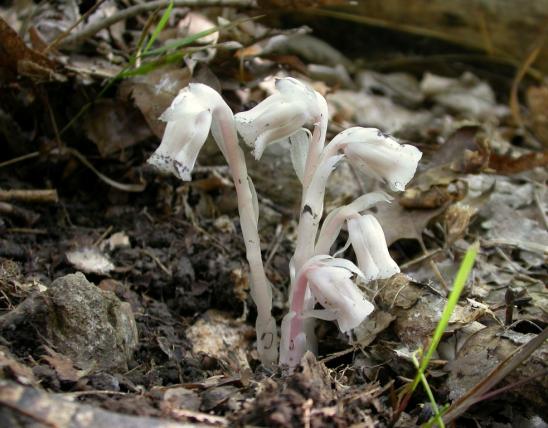
Pinesap is a small, fleshy perennial plant lacking chlorophyll. It can be misidentified as a mushroom. Stem and flower color ranges from yellow to pink, red, orange, or brown or some combination of these. Summer-blooming plants tend to be yellowish, and those blooming in fall tend to be more pinkish or reddish. Rarely, they exhibit odd color patterns, such as red or white spirals like a candy cane, or red stems with yellow flowers. Flowers usually several, in a nodding raceme at the top of the stem. Blooms June–October. Leaves alternate, up to ½ inch long, stalkless, often hairy or fuzzy, clasping the stem. Fruit a dry capsule up to ¼ inch long. During fruiting, the previously nodding stem straightens, becoming erect.
Similar species: Indian pipe (M. uniflora) has a single flower per stem and is usually whitish, sometimes pinkish.
Height: up to 10 inches.

Scattered nearly statewide, occurring mainly in parts of the Ozarks and in a few north-central counties. It is mostly absent from the Unglaciated Plains Division.
Habitat and Conservation
Found in bottomland forests, moist to dry upland forests, ledges of bluffs, and occasionally banks of streams and rivers.
This plant lacks chlorophyll and cannot generate its own food. Instead, its roots connect with fungi in the soil: The pinesap parasitically absorbs nutrients from a host fungus, which, in turn, acquires its nutrients through a mutually beneficial association with tree roots.
Status
Native Missouri perennial wildflower.
The species epithet is sometimes spelled hypopithys based on a misspelling in Carolus Linnaeus's original description of the plant.
Botanists are working to unravel the patterns of variation in this unusual plant, and future studies may show that two or more hard-to-distinguish species have been masquerading under the name "M. hypopitys."
Pinesap is in the same family as blueberries, cranberries, heaths, azaleas, and rhododendrons.
Human Connections
Plants in this genus were used historically as an eye tonic, sedative, analgesic, and general tonic, among other medicinal uses.
Ecosystem Connections
When we talk of food webs, we usually think only of plants that generate sugars via photosynthesis, the herbivores that eat them, and the carnivores that eat them. But parasitic plants, and fungi that form partnerships with tree roots, are also part of the food web!


























